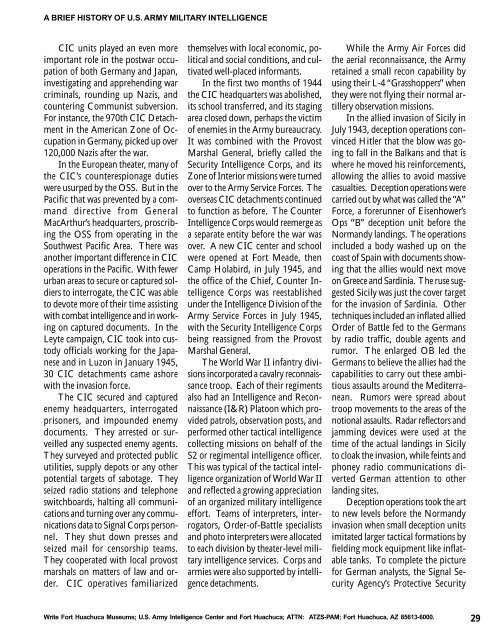Brief History of Army MI - Fort Huachuca - U.S. Army
Brief History of Army MI - Fort Huachuca - U.S. Army
Brief History of Army MI - Fort Huachuca - U.S. Army
Create successful ePaper yourself
Turn your PDF publications into a flip-book with our unique Google optimized e-Paper software.
A BRIEF HISTORY OF U.S. ARMY <strong>MI</strong>LITARY INTELLIGENCECIC units played an even moreimportant role in the postwar occupation<strong>of</strong> both Germany and Japan,investigating and apprehending warcriminals, rounding up Nazis, andcountering Communist subversion.For instance, the 970th CIC Detachmentin the American Zone <strong>of</strong> Occupationin Germany, picked up over120,000 Nazis after the war.In the European theater, many <strong>of</strong>the CIC’s counterespionage dutieswere usurped by the OSS. But in thePacific that was prevented by a commanddirective from GeneralMacArthur’s headquarters, proscribingthe OSS from operating in theSouthwest Pacific Area. There wasanother important difference in CICoperations in the Pacific. With fewerurban areas to secure or captured soldiersto interrogate, the CIC was ableto devote more <strong>of</strong> their time assistingwith combat intelligence and in workingon captured documents. In theLeyte campaign, CIC took into custody<strong>of</strong>ficials working for the Japaneseand in Luzon in January 1945,30 CIC detachments came ashorewith the invasion force.The CIC secured and capturedenemy headquarters, interrogatedprisoners, and impounded enemydocuments. They arrested or surveilledany suspected enemy agents.They surveyed and protected publicutilities, supply depots or any otherpotential targets <strong>of</strong> sabotage. Theyseized radio stations and telephoneswitchboards, halting all communicationsand turning over any communicationsdata to Signal Corps personnel.They shut down presses andseized mail for censorship teams.They cooperated with local provostmarshals on matters <strong>of</strong> law and order.CIC operatives familiarizedthemselves with local economic, politicaland social conditions, and cultivatedwell-placed informants.In the first two months <strong>of</strong> 1944the CIC headquarters was abolished,its school transferred, and its stagingarea closed down, perhaps the victim<strong>of</strong> enemies in the <strong>Army</strong> bureaucracy.It was combined with the ProvostMarshal General, briefly called theSecurity Intelligence Corps, and itsZone <strong>of</strong> Interior missions were turnedover to the <strong>Army</strong> Service Forces. Theoverseas CIC detachments continuedto function as before. The CounterIntelligence Corps would reemerge asa separate entity before the war wasover. A new CIC center and schoolwere opened at <strong>Fort</strong> Meade, thenCamp Holabird, in July 1945, andthe <strong>of</strong>fice <strong>of</strong> the Chief, Counter IntelligenceCorps was reestablishedunder the Intelligence Division <strong>of</strong> the<strong>Army</strong> Service Forces in July 1945,with the Security Intelligence Corpsbeing reassigned from the ProvostMarshal General.The World War II infantry divisionsincorporated a cavalry reconnaissancetroop. Each <strong>of</strong> their regimentsalso had an Intelligence and Reconnaissance(I&R) Platoon which providedpatrols, observation posts, andperformed other tactical intelligencecollecting missions on behalf <strong>of</strong> theS2 or regimental intelligence <strong>of</strong>ficer.This was typical <strong>of</strong> the tactical intelligenceorganization <strong>of</strong> World War IIand reflected a growing appreciation<strong>of</strong> an organized military intelligenceeffort. Teams <strong>of</strong> interpreters, interrogators,Order-<strong>of</strong>-Battle specialistsand photo interpreters were allocatedto each division by theater-level militaryintelligence services. Corps andarmies were also supported by intelligencedetachments.While the <strong>Army</strong> Air Forces didthe aerial reconnaissance, the <strong>Army</strong>retained a small recon capability byusing their L-4 “Grasshoppers” whenthey were not flying their normal artilleryobservation missions.In the allied invasion <strong>of</strong> Sicily inJuly 1943, deception operations convincedHitler that the blow was goingto fall in the Balkans and that iswhere he moved his reinforcements,allowing the allies to avoid massivecasualties. Deception operations werecarried out by what was called the “A”Force, a forerunner <strong>of</strong> Eisenhower’sOps “B” deception unit before theNormandy landings. The operationsincluded a body washed up on thecoast <strong>of</strong> Spain with documents showingthat the allies would next moveon Greece and Sardinia. The ruse suggestedSicily was just the cover targetfor the invasion <strong>of</strong> Sardinia. Othertechniques included an inflated alliedOrder <strong>of</strong> Battle fed to the Germansby radio traffic, double agents andrumor. The enlarged OB led theGermans to believe the allies had thecapabilities to carry out these ambitiousassaults around the Mediterranean.Rumors were spread abouttroop movements to the areas <strong>of</strong> thenotional assaults. Radar reflectors andjamming devices were used at thetime <strong>of</strong> the actual landings in Sicilyto cloak the invasion, while feints andphoney radio communications divertedGerman attention to otherlanding sites.Deception operations took the artto new levels before the Normandyinvasion when small deception unitsimitated larger tactical formations byfielding mock equipment like inflatabletanks. To complete the picturefor German analysts, the Signal SecurityAgency’s Protective SecurityWrite <strong>Fort</strong> <strong>Huachuca</strong> Museums; U.S. <strong>Army</strong> Intelligence Center and <strong>Fort</strong> <strong>Huachuca</strong>; ATTN: ATZS-PAM; <strong>Fort</strong> <strong>Huachuca</strong>, AZ 85613-6000.29
















